Some Good, Some Bad
/0 Comments/in Flowers, Fruit, Gardening, Pests/by Lee ReichPicking Pecks and Pecks of Peppers
Warm — no, hot — weather going on and on keeps tomatoes, cucumbers, and peppers chugging along, restrained only by diminished sunshine. Still, before real autumn weather rolls in and decimates these warmth-loving plants, it’s time to do some evaluation of this season before it fades into memories that meld with previous seasons.
As usual, there are successes and failures. Good — no, great — are this year’s peppers. I credit the rousing success mostly to My choice of two varieties. The first was an old variety, Sweet Italia, aka Sweet Italian or Italian Sweet. Other varieties are available with similar names; the names are similar, but not the same, as are the fruits.
Sweet Italia has two problems: The seed is hard to find; and the plants flop over under their weight of fruit. Both problems are easily solved: Save seed (Sweet Italia is not a hybrid, so seeds come “true” as long as the plants are sufficiently distant from other pepper varieties); stake the plants. Sweet Italia is especially notable for bearing large and relatively early crops of deliciously sweet red peppers even under northern growing conditions. It’s much, much tastier than Sweet Ace, which is often grown commercially as an early ripening, sweet red pepper.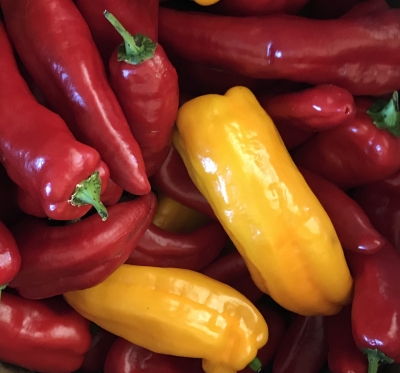
The other pepper variety of note is Escamillo, larger than Sweet Italia and also delicious, in a different way. Escamillo, bred by Johnny’s Selected Seeds, ripens yellow. Like Sweet Italia, Escamillo is a corno di toro, shaped like the horn of a bull.
Blight!!
Balancing my peppery successes are two failures celery and celeriac. Plants looked healthy from the time I sowed seed, indoors in February, until the transplants went out in the garden, in early May. It was downhill from there.
Plants are stunted and their leaves are spotted by disease. The spots are very distinctive, tan with black edges, and angular in outline. The tan areas lacked pycnidia, small, black propagules visible with the naked eye, so the disease is not one of the fungal diseases that afflict celery and celeriac.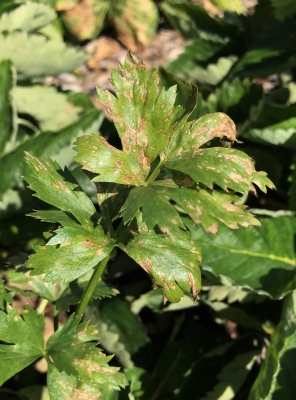
A web search of symptoms and images identified the problem as bacterial blight (Pseudomonas syringae pv. apii). Cool, wet weather exacerbates the condition, and we did have some of that this summer. The fungus can also spend the winter in the soil, which makes a good case for crop rotation, not planting any member of a family of plants in the same place oftener that every 3 years. I did move my celery and celeriac far from previous two locations, though.
I’m pinning the blame on seedling flats that were not sufficiently cleaned. Usually, I just give them a rinse after use; next year they’ll also get a spritzing with alcohol.
Infected seed could also have been the culprit — doubtfully in my garden. The celeriac seed was from a reputable nursery. What’s more, the celery seed comes from my own plants, in the greenhouse. Those plants also self-seed in the greenhouse, and the volunteer plants that come up in the greenhouse look fine. (I thin them out, letting the best ones grow to provide celery all winter, and then self-seed again in spring.)
If infected, seed could be de-contaminated with a hot water treatment, 122°F for 25 minutes. Or with time. Seeds more than two years old don’t carry disease.
Other plans for next year are to be even more thorough with end-of-season cleanup of beds and to rip out of the ground any plants suspected of harboring disease as soon as noticed.
As a last resort, copper sprays, which are approved for organic use, could be applied. I probably won’t do that; it takes the fun out of just popping fresh vegetables into your mouth in among the beds. I have plenty of other good stuff to eat out there.
A Fruitful Season
In fruits, pears have been outstanding this year. Not because of any greenness of my thumb; everybody around here had good crops of pears. Must be something about the weather.
Also outstanding have been grapes. Again, not because of the greenness of my thumb, but because I have so many vines and so many different varieties. Despite weather conducive to diseases, there were — and still are — plenty of good grapes for eating.
Flowers did fine this year, except Lemon Gem marigolds, one flower that I try each year to sow enough of to define the leading edges of the beds in the vegetable garden. They typically germinate poorly for me, but they occasionally self-seed. I couldn’t bear to remove the few that popped up in the main path near the leading edges of the beds. Their general absence makes those few all the more outstanding.
They typically germinate poorly for me, but they occasionally self-seed. I couldn’t bear to remove the few that popped up in the main path near the leading edges of the beds. Their general absence makes those few all the more outstanding.
Taste And Aroma
/2 Comments/in Fruit, Gardening, Pests/by Lee ReichOld Peaches
The peaches on a friend’s tree were small, marred with bacterial spot disease, and still showed some green on their skins. So burdened with fruits was the tree that it had burst asunder from their weight, splitting one of the main limbs.
Still, the friend insisted that the peaches tasted good. As further enticement, the tree had a history, having sprouted on the grounds of a nearby 18th century house that had an orchard. The tree was evidently cold hardy also. So I twisted one fruit off and took a bite. In spite of being not quite ripe, the fruit was delicious, quite sweet — as is usual with white peaches such as these — and with an old-fashioned, intensely peachy flavor.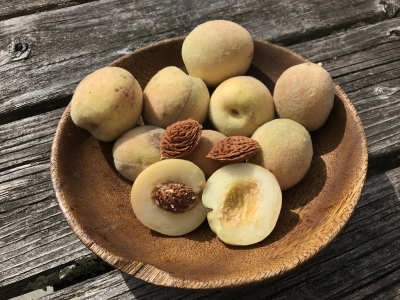
I took up the offer to take a small bag of them home with me. And not only for eating. My plan is to save the seeds from many of them for planting and for making into new trees that should taste very much like their mother tree. Peaches are self-pollinating, in contrast to apples and pears, so progeny often resemble their parent. Peaches also bear within just a few years from seed so I could weed out some or all plants whose fruits were not up to snuff.
The first step to a peachy future was to crack open the shells surrounding each seed, and then drop the seeds into a plastic bag filled with potting soil on the workbench in my unheated garage.
In their natural environment, peach seeds ripen in summer but wouldn’t sprout until spring. If they sprouted immediately, winter cold would likely kill the very young seedling. Hormones within the seeds sense when winter has ended by the number of accumulated hours at cool (30 to 45°F) temperatures.
The number of hours depends on the genetics of the tree but for most hardy fruit trees, about 1000 hours, or about a month and a half, does the trick. And I do intend to trick them, to give them an early start on the season, indoors. The more they grow each season, the sooner they bear.
I’d like them to sprout in early March, so will put the bag of potting soil and peach seeds into my refrigerator in early December. Once they sprout, I’ll pot a few up and, once they emerge from the soil, move them to the sunniest window or the greenhouse, then, when weather warms, outdoors.
It’s a Weed, It’s a Garden Plant, It’s a . . .
Some plants straddle the fence of being defined as a weed. Case in point is Sweet Annie. On looks alone, the plant could easily fall to one side of the fence, qualifying only as a weed. It’s nothing more than a nondescript, upright plant — until it bends over from it’s own weight — that’s green, clumps of them sprouting all over the place. Despite being a member of the Daisy Family of plants, Sweet Annie’s flowers are small, pale green, and not notable.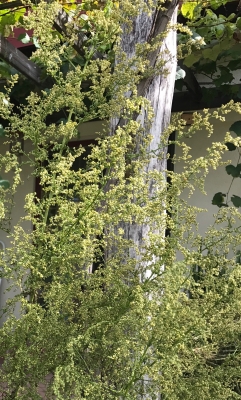
I, and many other gardeners, grow the plant for its rich, resiny aroma. Bundles of them are for sale from many farms at Maine’s Common Ground Fair; it’s the signature aroma there. So I also grow Sweet Annie to bring me back, olfactorily speaking, to my good times at the Fair.
As a sometime weed, Sweet Annie is, of course, easy to grow. I first planted it 3 years ago, sowing it, unnecessarily, in pots for later transplanting. No need to plant it again; it self-seeds enthusiastically, my job now being to contain that enthusiasm.
Amazing how that plant can move around. It managed to find its way from the back of my house to the front of my house without going around either side. It manages to sprout in spaces between the bricks of my terraces holding the thinnest slivers of soil.
Sweet Annie is sometimes cultivated as a row crop for harvest and extraction of artemisinin, which has some medicinal uses. As for me, I just weed out plants in the wrong place (as defines a weed), and harvest a few bunches to hang near the door for an olfactory treat as I brush past it.
How Pesky And Interesting
/0 Comments/in Fruit, Gardening, Pests, Vegetables/by Lee ReichSnowflakes? No.
Gardening never ceases to be interesting, even if the current object of interest is a pest. Not just any pest, but a NEW pest! And not just for me.
I was alerted to this pest when pulling a few weeds near my Brussels sprouts plants. Brushing against their leaves brought a cloud of what looked like fine snowflakes. They were, in fact, whiteflies, tiny (1.5 mm) fluttering insects, immediately recognizable to me from their common occurrence on houseplants.
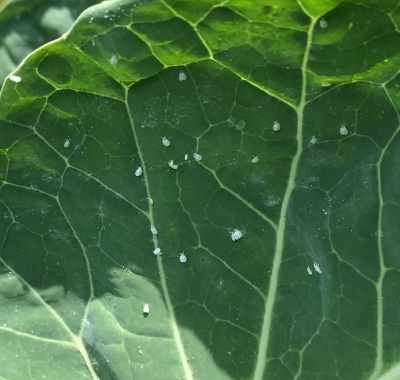
Cabbage whitefly
Whiteflies rarely show up on outdoor plants; in my experience, never. Easy enough to discover on the web, my whiteflies are appropriately named cabbage whiteflies (Aleyrodes protella). This native of Europe first turned up in the U.S. in 1993, but is rare in the Hudson Valley. It’s fond of all cabbages relatives, with a preference for kale. Not in my garden, though; kale, sharing the bed with the Brussels sprouts, is hardly attacked.
The attack seems mild, most evident, besides the snow clouds, as some black, sooty mold on the plants. Sooty mold is a fungus that feeds on the sweet exudate the insect drips on the plant. It’s only on the surface of the leaf so is harmless unless it becomes so dense that the leaf is shaded.
Cabbage whitefly isn’t easily controlled with chemical pesticides. I’m not worried, though, because the level of damage doesn’t warrant my lifting a finger against them.
If some control is needed before the season ends, sprays of either insecticidal soap or horticultural oils are effective — and won’t disrupt the whiteflies’ natural insect and fungal enemies, of which there are plenty. Cleaning up the bed at the end of the season also helps, for next year. Yellow-colored cards coated with something sticky, like Tangletrap, also could offer some control. For now, though, I’m just watching them flit about each time I draw near.
Peach Harvest
The peach crop got harvested a few days ago, all two of them. The tree is small, but not that small; it could have supported a couple of gallons of peaches.
This was a good season for peaches. Unfortunately, my farmden is not a good site for fruit. Insect pests can move in from the woods only 50 feet from the trees, and the low lying ground acts like a basin into which cold air can collect. That cold air brings late frosts (not this year), and moister air in which fungal diseases fester. Those are my excuses for my two-peach harvest.
On the other hand, my investment in the tree has been minimal. The tree grew from a peach pit. Sow an apple seed and the tree might take 10 years before it yields its first fruit. And then, after that long wait, the chance of that fruit tasting good is only about one in 10,000.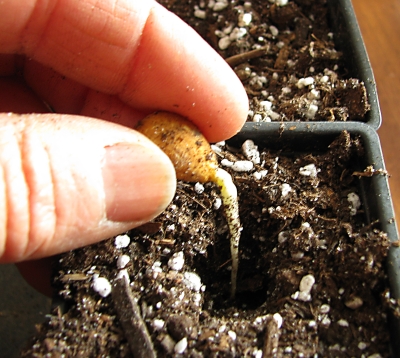
Sow a peach seed, and the tree might bear in 4 years. The fruit on that tree is likely to taste quite good, perhaps great. Peaches are self-pollinating, so there’s no foreign genes introduced into the resulting pit. Not so for apples, which don’t bear fruit unless pollinated by a different variety.
My peaches, by the way, tasted great. And, with gracefully drooping leaves that retain their shiny green color all season long, the tree is very attractive. I am hoping for a larger crop next year.
Ladybugs to the Rescue
Aha. Checked back with the whiteflies on the Brussels sprouts, and what do I see? Some ladybugs dining, moving up and down the leaves. The young larvae are likewise at work along with their parents.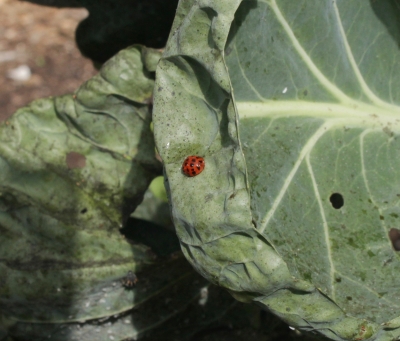
(The “lady” in ladybug is, by the way, the virgin Mary. The German word for them, Marienkafer, translates also as Marybeetle.)
Among the many species of ladybug, all in the family Coccinellidae, are some that specialize in devouring mites, others specialize in mildews, still others on mealybugs (I mentioned last week purchasing and using them for fig mealybugs), some for scale insects, and so on. Some members of the family feed on plants: squash beetles and Mexican bean beetles, for instance.
I don’t know which species of ladybug is at work on my Brussels sprouts, but I’m happy to have them.
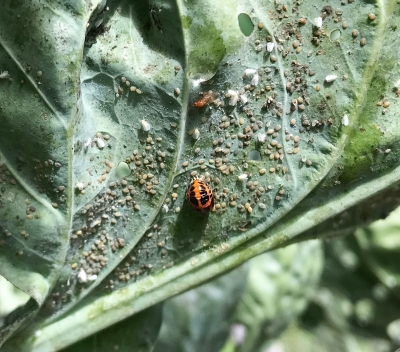
Cabbage whitefly & ladybug larvae

